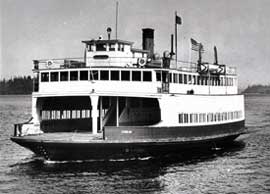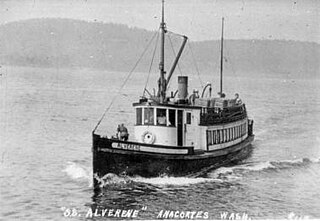Related Research Articles

Washington State Ferries (WSF) is a government agency that operates automobile and passenger ferry service in the U.S. state of Washington as part of the Washington State Department of Transportation. It runs ten routes serving 20 terminals located around Puget Sound and in the San Juan Islands, designated as part of the state highway system. The agency maintains the largest fleet of ferries in the United States at 21 vessels. In 2021, the system had a ridership of about 56,800 per weekday as of the third quarter of 2022. As of 2016, it was the largest ferry operator in the United States and the second-largest vehicular ferry system in the world.

State Route 104 (SR 104) is a 31.75-mile-long (51.10 km) state highway in the U.S. state of Washington, serving four counties: Jefferson on the Olympic Peninsula, Kitsap on the Kitsap Peninsula, and Snohomish and King in the Puget Sound region. It begins south of Discovery Bay at U.S. Route 101 (US 101) south of Discovery Bay and crosses the Hood Canal Bridge over Hood Canal to the terminus of SR 3 near Port Gamble. SR 104 continues southeast onto the Edmonds–Kingston Ferry to cross the Puget Sound and intersects SR 99 and Interstate 5 (I-5) before ending at SR 522 in Lake Forest Park. SR 104 also has a short spur route that connects the highway to SR 99 at an at-grade signal on the Snohomish–King county line.

Kitsap Transit is a public transit agency serving Kitsap County, Washington, part of the Seattle metropolitan area. The system is based in Bremerton and operates bus service on 40 fixed routes, a foot ferry, a vanpool system, worker-driver services, and dial-a-ride services. The Kitsap Fast Ferries are also operated by Kitsap Transit. In 2021, the system had a ridership of 1,736,100, or about 58,000 per weekday as of the third quarter of 2022.
The M/V Kitsap was a ferry built in 1925 at the Lake Washington Shipyard in Houghton, Washington. She was 165 feet (50 m) long, and her original capacity in 1925 was 95 cars and approximately 800 passengers. By 1960, cars had become much bigger and her capacity was reduced to 32 modern automobiles and 325 passengers. A 600-horsepower Estep diesel engine allowed her to sail at 12 knots when originally built. Almost every part of her was from Washington state; her hull and superstructure were built from Washington-grown fir, and her Estep engine was built in at Washington Iron Works in Tacoma.

The U.S. state of Washington is home to a number of public and private ferry systems, most notably the state-run Washington State Ferries.

State Route 304 (SR 304) is a state highway in Kitsap County, Washington, United States. It connects SR 3, a regional freeway, to the Puget Sound Naval Shipyard and downtown Bremerton. The designation of SR 304 continues onto the Seattle–Bremerton ferry operated by Washington State Ferries to Colman Dock in Downtown Seattle, terminating at SR 519 on Alaskan Way.

Colman Dock, also called Pier 52, is the primary ferry terminal in Seattle, Washington, United States. The original pier is no longer in existence, but the terminal, now used by the Washington State Ferry system, is still called "Colman Dock".
The Kitsap County Transportation Company was an important steamboat and ferry company that operated on Puget Sound. The company was founded in 1898 as the Hansen Transportation Company.

The Alki–Manchester ferry was a ferry route in Washington State that from 1925 to 1936 ran between Alki Point and Manchester, Washington, across Puget Sound.

The Astoria–Megler ferry, also called the Astoria–McGowan ferry and the Astoria–North Beach ferry, ran across the Columbia River between Astoria, Oregon, and two ferry docks near the present small community of Megler, Washington, from 1921 to 1966.

Camano was a steamboat built in 1906 at Coupeville, Washington which operated on Puget Sound from 1906 to 1917. Camano was later known as Tolo. As Tolo the vessel was sunk in 1917 as a result of a collision at sea. Four people died as a result.

Alverene was a gasoline launch built in 1912 which operated on northern Puget Sound and in the San Juan Islands.

The Port Madison-Suquamish-Poulsbo route was a shipping route that originated from Seattle, Washington. The route included stops at Port Madison, Suquamish, and Poulsbo, Washington. As of January 1, 1917, the Kitsap County Transportation Company was operating steamboats on the route. The company also owned a dock at Suquamish and 2,200 feet of waterfront property at Port Madison.
The Harper-Colby-Manchester route was a shipping route that originated from Seattle, Washington. The route included stops at Colby, Suquamish, and Manchester, Washington. As of January 1, 1917, the Kitsap County Transportation Company was operating steamboats on the route.
The Fletcher Bay–Brownsville–Manzanita route was a shipping route that originated from Seattle, Washington. The route included stops at Fletcher Bay, Brownsville, and Manzanita.

Pier 54 is a tourist pier in Seattle, Washington. Previously an active shipping pier and warehouse, Pier 54 was originally known as Pier 3 until it was renumbered during World War II. This pier was also known as Galbraith dock and the Galbraith Bacon dock. Because of the large number of smaller local steamships, generally built of wood, that used the pier up until the 1930s, the pier was also known as the “Mosquito Fleet dock”.

Suquamish, built in 1914, was the first diesel-engined passenger vessel in the United States. Much later Suquamish was converted to a commercial fishing vessel and was registered as a Canadian vessel under the name Terry.

Speeder was a motor launch built in 1908 which served on Puget Sound and in the San Juan Islands. From 1908 to 1922 this vessel was named Bainbridge.

Kitsap Fast Ferries is a passenger ferry service operating between Seattle and Kitsap County in the U.S. state of Washington. It is funded and operated by Kitsap Transit and began service in July 2017, with a single boat traveling between Seattle and Bremerton. A second route, from Seattle to Kingston, launched in November 2018, and a third route serving Seattle and Southworth began operating in March 2021. In 2021, the system had a ridership of 573,200, or about 3,200 per weekday as of the third quarter of 2022.

Captain John Laurentius Anderson was a preeminent figure in Washington state maritime industries in the first half of the twentieth century, particularly ferry service, shipbuilding, and ship-based tourism. He ran the largest ferry fleet on Lake Washington for three decades. He ran a large ferry fleet in Puget Sound. He built more than a dozen vessels at his shipyards, including the first ocean-going ship ever built on Lake Washington.
References
- Public Service Commission of Washington, Complainant, v. Kitsap County Transportation Company, Respondent, Case No. 4274, published in State of Washington, Public Service Commission, Annual Report (1916), at page 150 (accessed 06-04-11)]
- Federal Writers Project, Washington – A Guide to the Evergreen State (1935) (accessed 06-05-11)